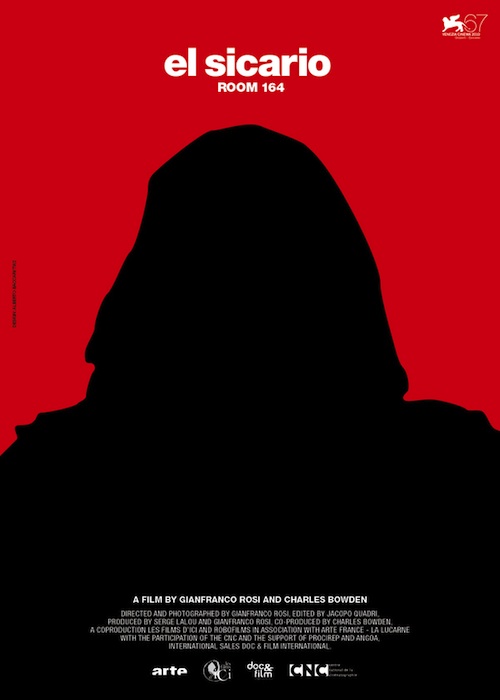 By Joe Bendel. Don’t ask who that masked man is. You don’t want to know. In 2009, a ‘sicario’ (a professional killer working for the Mexican drug cartels) gave an in-depth interview to Charles Bowden for a revealing Harper’s article. Despite the cartel’s $250,000 bounty, he subsequently consented to a lengthy on-camera interview with Bowden’s filmmaker colleague Gianfranco Rosi, who shaped his pseudo-confession into the documentary El Sicario, Room 164 (trailer below), now playing in New York at Film Forum.
By Joe Bendel. Don’t ask who that masked man is. You don’t want to know. In 2009, a ‘sicario’ (a professional killer working for the Mexican drug cartels) gave an in-depth interview to Charles Bowden for a revealing Harper’s article. Despite the cartel’s $250,000 bounty, he subsequently consented to a lengthy on-camera interview with Bowden’s filmmaker colleague Gianfranco Rosi, who shaped his pseudo-confession into the documentary El Sicario, Room 164 (trailer below), now playing in New York at Film Forum.
Rosi and Bowden are deliberately sketchy about the details, but the film was shot in a border town hotel room (number 164), where the masked sicario once held and tortured someone who owed money to his cartel. Eventually, he turned the battered man over to another team of sicarios. While he does not know his victim’s ultimate fate, he knowledgeably assumes a grisly end. Though this disturbing information seems to lend considerable significance to the location, it quickly becomes apparent the sicario has done such crimes innumerable times before in similar motels and so-called “safe houses” on either side of the border.
The sicario might very well be embellishing a host of individual details, but the broad strokes he sketches out ring chillingly true. Like a talented young baseball player, the sicario was recruited by his cartel at a young age. After serving a drug-running apprenticeship, the cartel greased his way into the police academy. Yes, the killer is also a copper. He estimates about a quarter of the graduates of all Mexico’s law enforcement academies are cartel plants. Not surprisingly, the free access to squad cars greatly simplifies the kidnapping process.
164 is all kinds of scary. Frankly, it makes it pretty clear narco-terrorist warlords have taken over the country. This is not happening in remote Afghanistan, but along our southern border. It is also evident the current administration is not capable of thinking sufficiently strategically over the long term to combat them in any meaningful way. Sending them a bunch of free guns as part of Operation Fast & Furious just is not going to do it.
Rosi focuses nearly exclusively on the hooded sicario as he uses a sketch pad to delineate the structure and methods of the cartels with icy precision. For occasional bumper shots, he shows scenes of the sicario’s scarred and sordid Juárez, sort of like Ozu transitions from Hell. Essentially, we are in that motel room (or one very much like it) listening to the anonymous assassin. It might not sound especially cinematic, but it is riveting.
If just half of what the sicario says is true, then the drug war is over in Mexico. The cartels won. It is tempting to get hung up on the particulars of his story, most notably his conversion story which rivals that of Saul on the road to Damascus. Then again, there must be some reason he is talking about the inner workings of his former business to director-cinematographer Rosi and co-producer Bowden, in defiance of the quarter million dollar price on his head. Indeed, it might be the most brutal talking head film ever produced, with the off-camera violence palpably lingering in the air. Recommended for viewers who can handle a talky dose of reality, 164 is now playing in New York at Film Forum.
Posted on December 29th, 2011 at 7:15pm.
If the drug war is over in Mexico and the cartels have won, where do you think they’ll be coming next?
I find it fascinating that the Spanish word for this type of killer is “sicario.” It derives from the Latin word “sicae” (dagger), which was the weapon of choice for Jewish terrorists in Judea in the first century CE, called “sicarii” by the Romans. The Sicarii killed Romans and Jews they considered to be working in league with the Romans (see Josephus’ “The Jewish Wars,” written not long after the fact, for more details). Forgotten history lives on in the words people use, the origins of which they are completely unaware of.